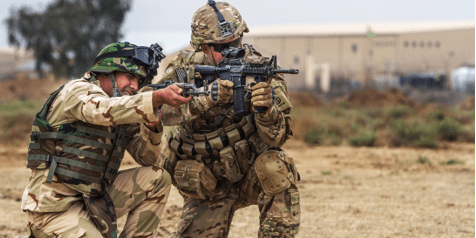
The Security Force Assistance Brigades (SFABs) are in the process of coming on line. The first SFAB will be stood up at Fort Benning, Georgia in the fall of 2017. The Army’s new advisor academy is now being organized and will also be located at Fort Benning. There will be six SFABs composed of officers and NCOs. Most NCOs will be E-6 or higher in rank.
The mission of the SFABs is Security Force Assistance (SFA). One of the core missions of special operations forces (SOF) is Foreign Internal Defense (FID); which at the tactical level is similar to the SFA mission (in respect to train, advise, and assist tasks). [1] So there is no surprise that the Army would envision close cooperation between the special operations community and the SFAB community. There are some differences between SFA and FID and sometimes the doctrinal definitions and descriptions can be confusing. [2]
So how will the SFABs and SOF work together? A recent paper published by the Association of the United States Army (AUSA) spells out how SFABs and SOF can “. . . collaborate to maximize resources, training efforts, and operational effectiveness.” [3] Some key initiatives that are currently underway or may be instituted in the future (as outlined in the AUSA paper cited below) include:
- Soldiers entering the SFABs or attending the Military Advisor Training Academy will travel to Fort Bragg, North Carolina for foreign weapons training taught be U.S. Army Special Forces instructors;
- Instructors and trainers from the USAJFKSWCS can work with course developers at the Military Advisor Training Academy to ensure best practices are replicated at Fort Benning;
- SOF units have a ‘regional orientation’. It is anticipated that the SFABs (there will be six) will also have a regional orientation. “Sharing regional alignment allows synchronization of training objectives and for maximum collaboration.”;
- “Qualified Special Forces officers and NCOs will be able to compete for brigade and battalion commands and command sergeants major as a second command opportunity.”
Footnotes:
[1] Jeffrey Hasler, a doctrine writer for The U.S. Army Special Operations Center of Excellence wrote this on the the differences and similarities of SFA and FID:
“At operational and strategic levels, both SFA and FID focus on developing an FSF’s internal capacity and capability. However, SFA also prepares FSF to defend against external threats and to perform as part of an international coalition. FID and SFA are similar at the tactical level where advisory skills are applicable to both”.
“Defining War 2001”, by Jeffrey Hasler, Special Warfare, January-February 2011. Posted on U.S. Army Special Operations Center of Excellence.
www.soc.mil/swcs/swmag/archive/SW2401/SW2401DefiningWar.html
[2] Read “What is the Difference Between FID and SFA?”, Afghan War News.
www.afghanwarnews.info/sfa/differenceFIDandSFA.htm
[3] See A New Breed of Advisory Team: Security Force Assistance Brigades to Collaborate with Special Operations Forces, Association of the United States Army (AUSA), June 19, 2017. This paper – authored by MG James B. Linder, MG Eric Wesley, and Capt Elliot Grant – provides the rationale for SFABs and the reasons that the SFABs and SOF will benefit from collaboration. MG Linder is currently the commander of the Special Operations Joint Task Force – Afghanistan (SOJTF-A) and formerly was the commanding general of the U.S. Army Special Operations Center of Excellence (commonly referred to as the ARSOF schoolhouse). MG Wesley is the commanding general of the U.S. Army Maneuver Center of Excellence at Fort Benning, Georgia. Capt Grant serves in the U.S. Army Special Operations Center of Excellence at Fort Bragg, North Carolina.
Editorial Note: Some readers asked for further clarification on the differences and similarities of SFA and FID. Footnote [1] was added to provide information from a doctrinal writer at the United States Army John F. Kennedy Special Warfare Center and School (USAJFKSWCS).